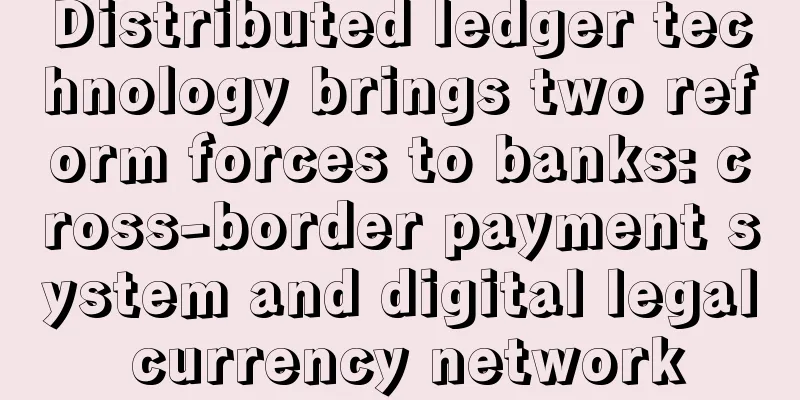Distributed ledger technology brings two reform forces to banks: cross-border payment system and digital legal currency network

|
The system we currently use to move money is large, complex, expensive, and has no rules. It needs to change. And that change is coming, in the form of distributed ledgers, digital signatures, and virtual currencies. Banks, the traditional middlemen in money movement, must start developing strategies to address the threats posed by these technologies. According to the statistics of Bain Consulting Company, the cross-border money transfer network handles nearly Given the high potential risks of digital currencies and the instability of their transaction tracking, it is understandable that banks want to be careful. For example, in early August, the Hong Kong Bitcoin exchange Bitfinex was attacked and lost nearly $65 million. Bitcoin is supported by blockchain, which is widely known for its distributed ledger function. However, the digitalization of fund transactions is unstoppable, and the innovation of financial technology companies and the service needs of corporate users are important factors driving this force. According to a recent survey by the Association of Financial Professionals (AFP) and Temenos (which provides integrated and modular core bank account systems), about 60% of corporate financial managers are dissatisfied with the payment services provided by their banks and are looking for other options. Distributed ledgers will bring two forces of reform. First, the development of cross-border payment systems , and reforms in this area are in full swing . Second, digital fiat domestic payment networks supported by central banks . Although this type of reform has not yet been carried out, it will definitely have a long-term impact on the banking system in the future, and it is likely to completely subvert the entire checking account and credit card market. The nature of distributed ledgers is worth considering. Traditional payment and transfer models rely heavily on centralized institutions. When funds flow between transaction participants, this centralized institution is responsible for recording and monitoring transactions to prevent fraud; then the transaction parties verify the specific information through their own systems. This process protects all participants at the same time, but the cost is too high, it is also time-consuming, and even leads to the breeding of bureaucracy. A distributed ledger is a secure shared database where each participant can hold a copy of the data ledger. Once a transaction is initiated, it is verified by all participants in the network and can be updated in the network almost immediately. Transactions can be initiated using encrypted digital signatures, without relying on centralized institutions to verify transactions. The distributed ledger system itself only ensures that the entire network holds the same version of the ledger data. In other words, distributed ledgers completely eliminate the middleman. There is no shortage of innovators in the field of international correspondent banking. For example, San Francisco-based startup Ripple has built a payment system based on a custom protocol and currency, and is currently working with about 30 banks to test its software. So, given their size and position, how should banks respond to the development of cross-border transactions? Putting aside some technical issues, the reform of the payment system requires the participation of multiple parties. In other words, banks need to establish alliances. Bank chains that operate across borders will choose local allies that have geographical advantages. Some large international banks usually need to handle a large number of cross-border transactions. When faced with reforms, they can choose to develop internal distributed ledger projects or cooperate with third-party platforms with great development potential. Such banks need to comply with strict anti-money laundering and know your customer (KYC) regulations. However, they can turn such regulations into a marketing tool to promote the security of their systems to customers. Distributed ledgers are not only important in the international correspondent banking sector, but will also bring about earth-shaking changes to domestic payment systems. The People's Bank of China and the Bank of England have begun exploring the issuance of a national digital currency based on a distributed ledger. Once such a system is available, consumers and businesses will be able to make electronic payments even without using credit cards or checking accounts. Such a system will also seriously affect the liquidity of bank deposits, which is a major source of their fiscal funds. As a result, banks have begun to invest heavily in digital wallets and payment apps. No one knows when these two forces will bring digital innovation to the international banking industry. But those banks that are already in the preparation stage will gain great adaptability. Bank executives can start by choosing partners, which customers, colleagues and third parties are suitable. Whether a bank is a cutting-edge innovator or a vigilant follower, it can win this war for itself. How banks respond to the challenges of distributed ledgers will determine the shape of the global financial system. For banks, digital payment networks are no longer a strategic option but a necessity. |
Recommend
Bitcoin is approaching the $20,000 mark. Is this a new round of tulip bubble?
In 1637, the tenth year of Emperor Chongzhen of t...
Coin Zone Trends: Bitcoin Price Trends Based on Big Data This Week (2017-07-25)
The price of the currency is facing a breakthroug...
Revealing the four types of colleagues you should keep your distance from
The interpersonal relationships in the office are...
Are people with one single eyelid and one double eyelid destined to be rich? Does having double eyelids bring good luck in marriage?
Speaking of eyelids, I believe many of my friends...
Full text of the U.S. Department of Justice: First arrest of crypto insider trading Coinbase former employee escape details like a blockbuster
Preface The U.S. Department of Justice once again...
Your shoes reveal your personality
Everyone has different aesthetic views and dressi...
The baby's face will conflict with his parents
Some people are born with a weak bond with their ...
Palmistry characteristics of easy money
Palmistry characteristics of easy money Everyone ...
What does a woman with messy palm lines mean?
According to Chinese physiognomy, a woman with fi...
How did ancient Chinese physiognomy tell tongue?
The tongue, as the law of things, obeys the Dan Y...
Xu Ziqi's face is extremely good
Who is Xu Ziqi? I believe I don't need to say...
Physiognomy explains what a crooked nose means. Do people with crooked noses have good fortune?
People with crooked noses are unlucky for their p...
Able to accommodate 4 billion assets, Ruizi Chain was born to prosper the digital currency market
introduction Until people gradually realized how ...
What kind of face can I do but I want to ask others for help?
Some people are like this. There are things that ...
What does a woman with a small mouth look like? Is fate good?
As one of the traditional physiognomy techniques, ...









